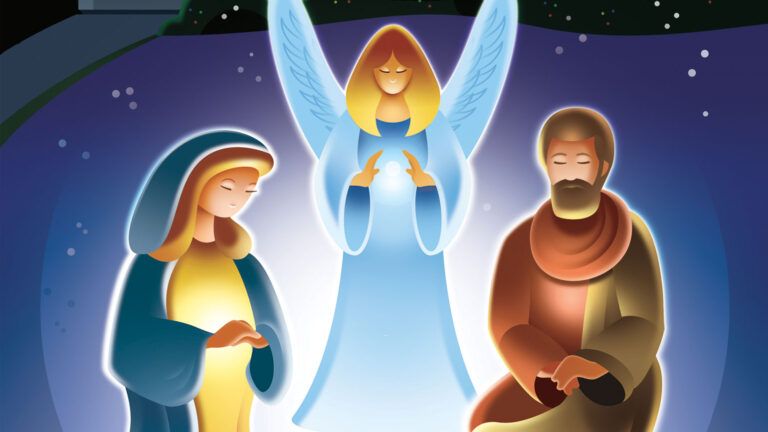It was in high school that I first started hearing about the battle between faith and science and how that battle had been won by science.
“Faith was fine in the Dark Ages when people didn’t know how the universe really worked,” my friend Bruce, an aspiring science major, would explain to me—with the tone of an adult explaining a completely obvious truth to a stubborn child. “But there’s no place for it in today’s world. It’s a crutch for people who don’t want to face the facts.”
A crutch? Really? Having grown up in an agnostic household, I saw myself as being free to approach the faith-versus-science question with an open mind. If I’d chosen to believe Bruce’s words, no one at home would have argued with me.
But to me there was no getting away from the fact that something—a certain irreducible element of mystery—was missing from the scientific explanation of the world. If the universe was just a big indifferent, self-perpetuating machine, how come life—my life—felt so strangely significant? What accounted for the overwhelming feeling I’d get sometimes that everything that happened to me—even down to the tiniest, seemingly most insignificant event—mattered?
“Of course you feel that way,” Bruce would say, pointing out that all the way up until the seventeenth century (thanks in large part to an astronomer and mathematician named Claudius Ptolemy) people had believed that the earth lay at the center of the universe.
“It’s like when a baby thinks the whole world revolves around him,” Bruce explained. “When you grow up, you realize it doesn’t. With science, humankind grew up.” That was the materialist’s view of things. It just didn’t sit well with me. So I continued to search.
Bruce was right about one thing. It’s natural to connect importance with centrality. From dartboards to the layout of seats at Madison Square Garden, the closer to the center you get, the more you count. Once Copernicus came along and showed how wrong Ptolemy had been about earth’s place in the universe, it was only natural that people started questioning the traditional view that human life—especially individual human life—really mattered.
For years I’d hear Bruce’s voice whenever I pondered questions about faith and science. But I couldn’t help feeling that our lives add up to more than the simple physical facts of existence.
That was why I felt so fortunate to have the chance to meet Professor Huston Smith. Professor Smith is one of my heroes. Like countless other young people with an interest in religion and philosophy, I first encountered him through his book The World’s Religions—the single most popular volume on comparative religion ever published.
The son of Christian missionaries, Smith—who’s now in his ninetieth year—grew up in rural China and came to America at the age of 17. He became a professor of philosophy, teaching for many years at Massachusetts Institute of Technology—a place where science is taken pretty seriously indeed.
He argued in his books that faith and science are complementary and equally true. The great mistake that science—or rather certain scientists—had made was to believe that just because science describes the material universe so brilliantly, it can describe every other aspect of reality just as well.
To understand how faith and science can both be true, Smith explained, you have to shift your focus—to learn how to look at life in two ways at once. The universe, according to this view, is a little like one of those optical puzzles in which a seemingly meaningless pattern on a flat page suddenly gives way to a 3-D image. Before you learn how to shift your vision, the idea that there’s a deeper image on the flat page seems unlikely. But once you learn how to make the shift, you can never go back to the flat-page-only view again.
According to the flat-page view of the universe (which, to give Bruce credit, is right as far as it goes), earth is just one tiny planet circling one star in a galaxy containing more than 100 billion other stars, which, in turn, floats in a 12-billion-year-old universe of 500 billion galaxies, give or take a few billion.
From that unimaginably vast perspective, it’s hard indeed to see an individual life as having special significance. But if you shift your gaze and see things using the eye of faith, you see a very different picture.
“The best single model of the universe from a religious standpoint,” Smith explained, “is the most time-honored image in the entire Christian faith: the cross.” Smith convinced me that it’s true. “The cross isn’t only the symbol of Christ’s death and resurrection,” Smith told me in his room on the seventh floor of his Central Park South hotel. “It’s also a map of where each of us actually is in the universe when seen from the spiritual perspective.”
Professor Smith drew a simple, two-line cross on the hotel pad on the coffee table in front of us. “What is a cross?” he asked. “It’s a horizontal line intersected by a vertical line at a single point. And that,” he said, pointing to the spot where the two lines intersected, “that meeting place between the spiritual and the material, the worldly and the divine, is actually what each of us actually is.
The horizontal line stands for the physical universe—the material world that science describes. Each of us lives in this material world, but at the same time, we’re also vertical creatures—spiritual beings. That vertical line runs directly through the center of each of us, and connects us directly to God—to the divine itself.”
I told Professor Smith about that sensation I got as a teenager—the sense that, against all odds, my little life was somehow infinitely significant. “That’s exactly it!” he said. “Your life is infinitely significant, as is everyone else’s life as well. God isn’t limited by the laws that govern our world.
While it is impossible for a physical object to be in two or more places at once, God isn’t limited in this way. Seen from a divine perspective, God is the center of the universe, and that center is everywhere. In those moments when you feel most deeply in touch with God, you naturally experience yourself as being at the very center of everything.”
Of course, to see oneself as being at the center of the cross of the universe can sound arrogant and sacrilegious. But listening to Professor Smith—who has a youthful sparkle in his eye that would do any 16-year-old proud—it felt anything but. My only wish was that Bruce could have been there with us. Listening to Smith, I felt that even Bruce might have been brought around to realizing that that room on the seventh floor of that New York hotel was indeed the very center of the universe.





